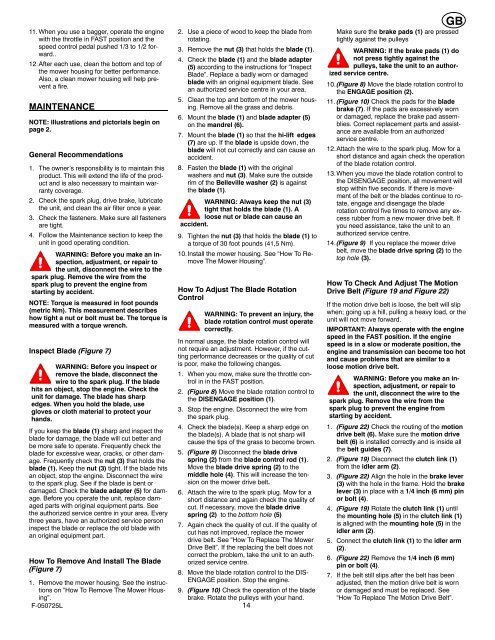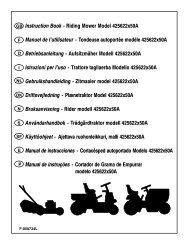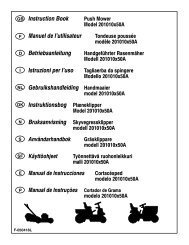Instruction Book − Riding Mower Model ... - Safe Motor AS
Instruction Book − Riding Mower Model ... - Safe Motor AS
Instruction Book − Riding Mower Model ... - Safe Motor AS
Create successful ePaper yourself
Turn your PDF publications into a flip-book with our unique Google optimized e-Paper software.
11. When you use a bagger, operate the engine<br />
with the throttle in F<strong>AS</strong>T position and the<br />
speed control pedal pushed 1/3 to 1/2 forward..<br />
12.After each use, clean the bottom and top of<br />
the mower housing for better performance.<br />
Also, a clean mower housing will help prevent<br />
a fire.<br />
MAINTENANCE<br />
NOTE: Illustrations and pictorials begin on<br />
page 2.<br />
General Recommendations<br />
1. The owner’s responsibility is to maintain this<br />
product. This will extend the life of the product<br />
and is also necessary to maintain warranty<br />
coverage.<br />
2. Check the spark plug, drive brake, lubricate<br />
the unit, and clean the air filter once a year.<br />
3. Check the fasteners. Make sure all fasteners<br />
are tight.<br />
4. Follow the Maintenance section to keep the<br />
unit in good operating condition.<br />
WARNING: Before you make an inspection,<br />
adjustment, or repair to<br />
the unit, disconnect the wire to the<br />
spark plug. Remove the wire from the<br />
spark plug to prevent the engine from<br />
starting by accident.<br />
NOTE: Torque is measured in foot pounds<br />
(metric Nm). This measurement describes<br />
how tight a nut or bolt must be. The torque is<br />
measured with a torque wrench.<br />
Inspect Blade (Figure 7)<br />
WARNING: Before you inspect or<br />
remove the blade, disconnect the<br />
wire to the spark plug. If the blade<br />
hits an object, stop the engine. Check the<br />
unit for damage. The blade has sharp<br />
edges. When you hold the blade, use<br />
gloves or cloth material to protect your<br />
hands.<br />
If you keep the blade (1) sharp and inspect the<br />
blade for damage, the blade will cut better and<br />
be more safe to operate. Frequently check the<br />
blade for excessive wear, cracks, or other damage.<br />
Frequently check the nut (3) that holds the<br />
blade (1). Keep the nut (3) tight. If the blade hits<br />
an object, stop the engine. Disconnect the wire<br />
to the spark plug. See if the blade is bent or<br />
damaged. Check the blade adapter (5) for damage.<br />
Before you operate the unit, replace damaged<br />
parts with original equipment parts. See<br />
the authorized service centre in your area. Every<br />
three years, have an authorized service person<br />
inspect the blade or replace the old blade with<br />
an original equipment part.<br />
How To Remove And Install The Blade<br />
(Figure 7)<br />
1. Remove the mower housing. See the instructions<br />
on “How To Remove The <strong>Mower</strong> Housing”.<br />
F-050725L<br />
2. Use a piece of wood to keep the blade from<br />
rotating.<br />
3. Remove the nut (3) that holds the blade (1).<br />
4. Check the blade (1) and the blade adapter<br />
(5) according to the instructions for “Inspect<br />
Blade”. Replace a badly worn or damaged<br />
blade with an original equipment blade. See<br />
an authorized service centre in your area.<br />
5. Clean the top and bottom of the mower housing.<br />
Remove all the grass and debris.<br />
6. Mount the blade (1) and blade adapter (5)<br />
on the mandrel (6).<br />
7. Mount the blade (1) so that the hi-lift edges<br />
(7) are up. If the blade is upside down, the<br />
blade will not cut correctly and can cause an<br />
accident.<br />
8. Fasten the blade (1) with the original<br />
washers and nut (3). Make sure the outside<br />
rim of the Belleville washer (2) is against<br />
the blade (1).<br />
WARNING: Always keep the nut (3)<br />
tight that holds the blade (1). A<br />
loose nut or blade can cause an<br />
accident.<br />
9. Tighten the nut (3) that holds the blade (1) to<br />
a torque of 30 foot pounds (41,5 Nm).<br />
10.Install the mower housing. See “How To Remove<br />
The <strong>Mower</strong> Housing”.<br />
How To Adjust The Blade Rotation<br />
Control<br />
WARNING: To prevent an injury, the<br />
blade rotation control must operate<br />
correctly.<br />
In normal usage, the blade rotation control will<br />
not require an adjustment. However, if the cutting<br />
performance decreases or the quality of cut<br />
is poor, make the following changes.<br />
1. When you mow, make sure the throttle control<br />
in in the F<strong>AS</strong>T position.<br />
2. (Figure 8) Move the blade rotation control to<br />
the DISENGAGE position (1).<br />
3. Stop the engine. Disconnect the wire from<br />
the spark plug.<br />
4. Check the blade(s). Keep a sharp edge on<br />
the blade(s). A blade that is not sharp will<br />
cause the tips of the grass to become brown.<br />
5. (Figure 9) Disconnect the blade drive<br />
spring (2) from the blade control rod (1).<br />
Move the blade drive spring (2) to the<br />
middle hole (4). This will increase the tension<br />
on the mower drive belt.<br />
6. Attach the wire to the spark plug. Mow for a<br />
short distance and again check the quality of<br />
cut. If necessary, move the blade drive<br />
spring (2) to the bottom hole (5)<br />
7. Again check the quality of cut. If the quality of<br />
cut has not improved, replace the mower<br />
drive belt. See “How To Replace The <strong>Mower</strong><br />
Drive Belt”. If the replacing the belt does not<br />
correct the problem, take the unit to an authorized<br />
service centre.<br />
8. Move the blade rotation control to the DIS-<br />
ENGAGE position. Stop the engine.<br />
9. (Figure 10) Check the operation of the blade<br />
brake. Rotate the pulleys with your hand.<br />
14<br />
GB<br />
Make sure the brake pads (1) are pressed<br />
tightly against the pulleys<br />
WARNING: If the brake pads (1) do<br />
not press tightly against the<br />
pulleys, take the unit to an authorized<br />
service centre.<br />
10.(Figure 8) Move the blade rotation control to<br />
the ENGAGE position (2).<br />
11. (Figure 10) Check the pads for the blade<br />
brake (7). If the pads are excessively worn<br />
or damaged, replace the brake pad assemblies.<br />
Correct replacement parts and assistance<br />
are available from an authorized<br />
service centre.<br />
12.Attach the wire to the spark plug. Mow for a<br />
short distance and again check the operation<br />
of the blade rotation control.<br />
13.When you move the blade rotation control to<br />
the DISENGAGE position, all movement will<br />
stop within five seconds. If there is movement<br />
of the belt or the blades continue to rotate,<br />
engage and disengage the blade<br />
rotation control five times to remove any excess<br />
rubber from a new mower drive belt. If<br />
you need assistance, take the unit to an<br />
authorized service centre.<br />
14.(Figure 9) If you replace the mower drive<br />
belt, move the blade drive spring (2) to the<br />
top hole (3).<br />
How To Check And Adjust The Motion<br />
Drive Belt (Figure 19 and Figure 22)<br />
If the motion drive belt is loose, the belt will slip<br />
when; going up a hill, pulling a heavy load, or the<br />
unit will not move forward.<br />
IMPORTANT: Always operate with the engine<br />
speed in the F<strong>AS</strong>T position. If the engine<br />
speed is in a slow or moderate position, the<br />
engine and transmission can become too hot<br />
and cause problems that are similar to a<br />
loose motion drive belt.<br />
WARNING: Before you make an inspection,<br />
adjustment, or repair to<br />
the unit, disconnect the wire to the<br />
spark plug. Remove the wire from the<br />
spark plug to prevent the engine from<br />
starting by accident.<br />
1. (Figure 22) Check the routing of the motion<br />
drive belt (6). Make sure the motion drive<br />
belt (6) is installed correctly and is inside all<br />
the belt guides (7).<br />
2. (Figure 19) Disconnect the clutch link (1)<br />
from the idler arm (2).<br />
3. (Figure 22) Align the hole in the brake lever<br />
(3) with the hole in the frame. Hold the brake<br />
lever (3) in place with a 1/4 inch (6 mm) pin<br />
or bolt (4).<br />
4. (Figure 19) Rotate the clutch link (1) until<br />
the mounting hole (5) in the clutch link (1)<br />
is aligned with the mounting hole (5) in the<br />
idler arm (2).<br />
5. Connect the clutch link (1) to the idler arm<br />
(2).<br />
6. (Figure 22) Remove the 1/4 inch (6 mm)<br />
pin or bolt (4).<br />
7. If the belt still slips after the belt has been<br />
adjusted, then the motion drive belt is worn<br />
or damaged and must be replaced. See<br />
“How To Replace The Motion Drive Belt”.





